The iPhone 5 Review
by Anand Lal Shimpi, Brian Klug & Vivek Gowri on October 16, 2012 11:33 AM EST- Posted in
- Smartphones
- Apple
- Mobile
- iPhone 5
Battery Life
Section by Anand Shimpi
At the start of our iPhone 4S battery life analysis I mentioned that I wasn't happy with the current state of our battery life benchmarks. The first incarnation of our smartphone battery life suite was actually a port of what I created to test battery life on Mac notebooks years ago. The Mac suite has evolved over time, and we've made similar evolutions to the smartphone suite - just on a less aggressive pace. The data on the previous page showed just how good Apple is at driving down idle power consumption, and through some software optimization it got very good at winning in our battery life tests. The data was accurate, but stopped being representative of reality.
Going into the iPhone 5 review I knew we needed to change the suite. After testing a number of options (and using about 16.5GB of cellular data in the process) we ended up on an evolution of the battery life test we deployed last year for our new tablet suite. The premise is the same: we regularly load web pages at a fixed interval until the battery dies (all displays are calibrated to 200 nits as always). The differences between this test and our previous one boil down to the amount of network activity and CPU load.
On the network side, we've done a lot more to prevent aggressive browser caching of our web pages. Some caching is important otherwise you end up with a baseband test, but it's clear what we had previously wasn't working. Brian made sure that despite the increased network load, the baseband still had the opportunity to enter its idle state during the course of the benchmark.
We also increased CPU workload along two vectors: we decreased pause time between web page loads and we shifted to full desktop web pages, some of which are very js heavy. The end result is a CPU usage profile that mimics constant, heavy usage beyond just web browsing. Everything you do on your smartphone ends up causing CPU usage peaks - opening applications, navigating around the OS and of course using apps themselves. Our 5th generation web browsing battery life test should map well to more types of smartphone usage, not just idle content consumption of data from web pages.
As always we test across multiple air interfaces (3G, 4G LTE, WiFi), but due to the increased network load we actually find that on a given process technology we see an increase in battery life on faster network connections. The why is quite simple to understand: the faster a page is able to fully render, the quicker all components can drive down to their idle power states.
The downside to starting with a new battery life test is that we don't have a wealth of older data to compare to. I did my best to run whatever we had access to at the time, but there simply aren't that many devices in these charts compared to our older ones. The data below may not look like a lot, but it's the result of running over 300 hours of battery life tests to not only understand how these devices do under load but also to find out the best test to use as the cornerstone of our new suite.
We'll start the investigation on WiFi. Where supported we used 5GHz 802.11n, otherwise 2.4GHz:
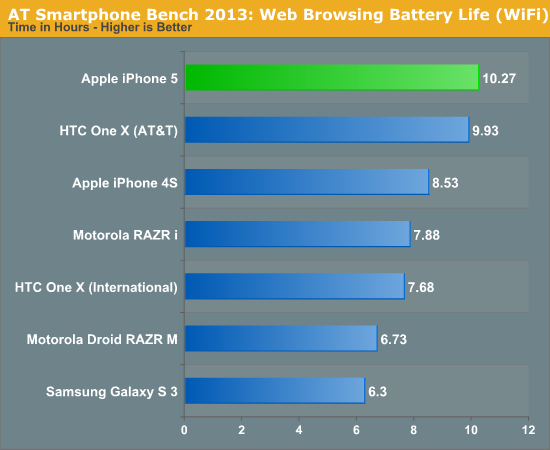
The iPhone 5 manages to match Apple's estimates, just breaking the 10 hour barrier. HTC's One X based on the Snapdragon S4 comes very close however. Although the One X is equipped with a larger battery, it also has a bigger screen and slightly more power hungry SoC to feed as well.
The iPhone 4S is measurably worse here. Keep in mind that the workload between all of the devices here is constant, if you use the faster performance on the iPhone 5 to browse more web pages or use your apps quicker then you may not see an improvement here. Worst case, you may even see a regression in battery life. That's the downside to this increased dynamic range in power consumption that we've been getting for two generations now.
Although this isn't the place for an Intel/Qualcomm comparison, it is important to note that the Atom Z2460 based RAZR i manages to last 17% longer on a single charge than the nearly identical, but Qualcomm S4 based RAZR M.
Next let's look at battery life when we switch to the cellular networks:
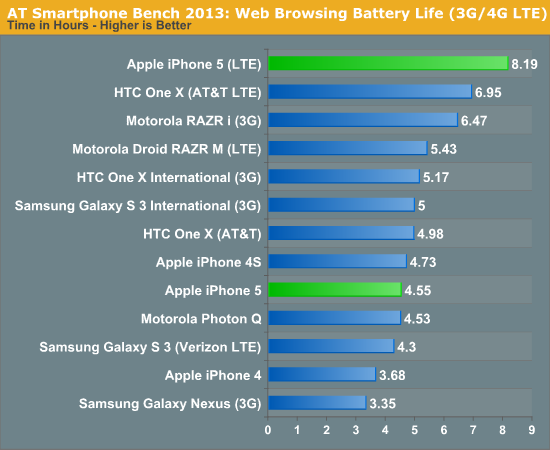
The non-LTE phones see a sharp drop in battery life. At least at 28nm the slower air interfaces simply have to remain active (and drawing power) for longer, which results in measurably worse battery life. Again, the thing to be careful of here is there's usually a correlation between network speed and how aggressive you use the device. With a workload that scaled with network speed you might see closer numbers between 3G and 4G LTE.
HTC's One X continues to do very well on LTE, coming the closest to the iPhone 5. I believe what we're seeing here is really Apple's idle power management building up a small but tangible advantage.
On 3G the iPhone 5 actually dies slightly quicker than the iPhone 4S, although run to run variance can cause the two to flip around in standings. Our iPhone 4 datapoint featured an older battery (both the 4S and 5 batteries were < 30 days old) so it's unclear how a brand new 4 would compare.
The RAZR i does quite well here on 3G. Despite being on a slower network, Intel's platform appears to do a good job of aggressively pushing down to idle. Once again Intel maintains about a 19% battery life advantage over the S4 based RAZR M. The RAZR i and the HTC One X do better than the iPhone 5 on 3G, which supports our theory of idle power consumption being a big reason the iPhone 5 does so well on faster networks.
While our new web browsing battery life tests do a good job of showing the impact of network, display and CPU on battery life, they do little to stress the GPU. Thankfully our friends at Kishonti gave us a shiny new tool to use: GLBenchmark 2.5.1 features a GPU rundown battery life test. The standard tests run Egypt and Egypt HD indefinitely until the battery life dies. We standardized on using Egypt HD at the device's native resolution with a 30 fps cap. All of the displays were calibrated to 200 nits as usual.
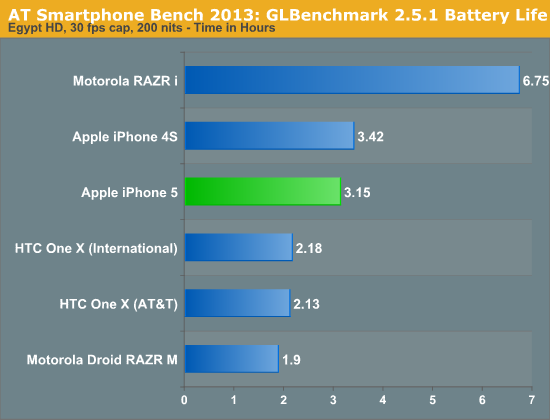
Here the iPhone 4S has a tangible advantage in battery life over the 5. The move to 32nm can only do so much, with many more transistors switching at a higher frequency the A6 SoC ends up drawing tangibly more power than the A5 in the iPhone 4S and delivers a shorter run on battery. The gap isn't huge (the 5 delivers 92% of the battery life of the 4S), but it's still a regression. The iPhone 5 does comparatively quite well here, despite being faster it's able to outlast the S4 and Tegra 3 based devices. The explanation is rather simple: capped to only 30 fps the iPhone 5's GPU likely has the ability to drop down to an idle state for a brief period in between rendering frames. The other devices can't hit 30 fps in this test and as a result have to run at full tilt throughout the entire benchmark. The RAZR i is the only exception to the rule, but it is considerably slower than everything else here (averaging below 8 fps) which could explain the very high result.
Moving on we have our WiFi hotspot test, which measures how long the device can last acting as a hotspot for a wirelessly tethered notebook. Our wireless hotspot test is entirely network bound by its definition. Here I'm including two sets of results, our most up to date LTE hotspot battery life tests as well as the chart we included in our latest iPad review. In both cases the iPhone 5 does relatively well, lasting just over 5 hours as an LTE hotspot on a single charge. In these tests, devices with significantly larger batteries come in very handy.
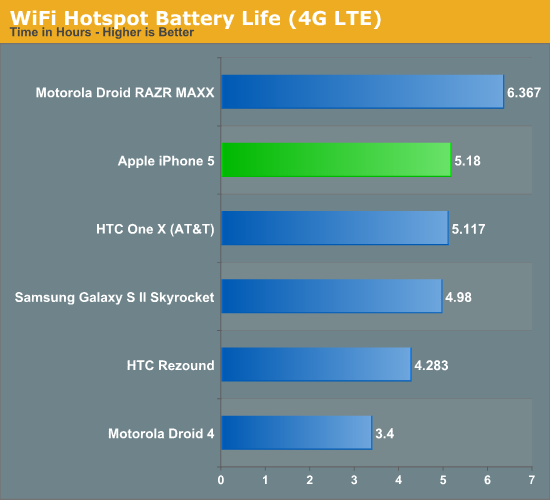

Our final battery life test is our standard call time test. In this test we're playing audio through two phones (one of which is the phone being tested) and measure the call time until the battery is completely drained. The display is turned off, simulating an actual call.
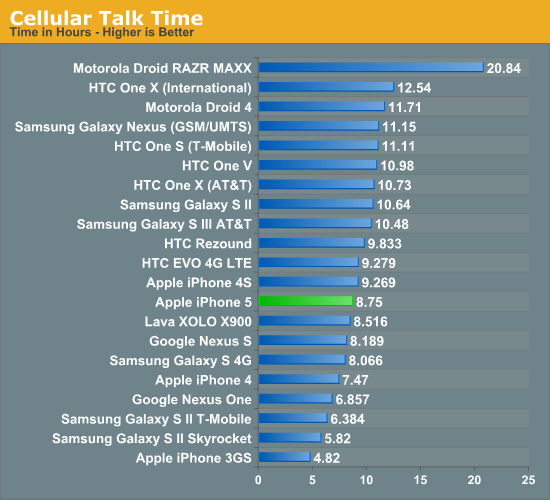
The iPhone 5 falls just short of the 4S in our call time test. There's really no major improvement here as far as we can tell, although it's not clear how much additional work the iPhone 5 is doing with its additional noise cancelling features. If talk time is of the utmost importance to you, you'll want to look at some of the phones with much larger batteries. The Droid RAZR MAXX remains the king of the hill as far as talk time is concerned.
Battery Life Conclusions
If we take a step back and look at the collection of results from our battery life tests, the iPhone 5 can last anywhere between 3.15 and 10.27 hours on a single charge. Do a lot of continuous data transfers and you'll see closer to 5 hours, but if you've got reasonably periodic idle time you can expect something in the 8 - 10 hour range. In short, if you use your device a lot, don't be too surprised to see it lose about 10 - 15% of its battery life for every hour of use.
Now the question is how does the iPhone 5 compare to other devices? Compared to previous iPhones, the 5 has the ability to use a lot more power. If you're doing the exact same, finite length CPU/network intensive task on the iPhone 5 and any previous iPhone, chances are that the iPhone 5 will be able to complete the task and get to sleep quicker - thus giving you a better overall energy usage profile. Where things get complicated is if you use the faster CPU, GPU and network connectivity to increase your usage of the device. In that case you could see no improvement or even a regression in battery life.
Compared to other modern platforms the iPhone 5 should be competitive in day to day power usage, even compared to devices with somewhat larger batteries (~7Wh). The trick to all of this of course is whatever performance advantage that the iPhone 5 has coupled with lower idle power. Being able to complete tasks quicker and/or drop to aggressively low idle power states are really the only secret to the iPhone's battery life.
I feel like the days of ever increasing smartphone battery life are behind us. Instead what we'll likely see going forward is continued increase in dynamic range. Battery life could be better or worse and it'll likely depend heavily on your workload. Much like how we saw notebooks cluster around the same 2 - 5 hour battery life for years, I suspect we'll see something similar here with smartphones. The major difference this time around is the burden of a really large battery isn't as big as it is in a notebook. The RAZR MAXX is the perfect example of a still very portable smartphone that comes equipped with a huge (by today's standards) battery.










276 Comments
View All Comments
Calista - Sunday, October 21, 2012 - link
English is not my native language (as I'm sure you have noticed) and so the flow in the language is far from flawless. But I still believe my opinions are valid and that the review was too long-winded.Teknobug - Wednesday, October 17, 2012 - link
I live in a big city and I don't know a single person that went and got the iPhone 5, most are happy with the iPhone 4 or whatever phone they're using, I don't see what's so great about the iPhone 5 other than it being built better than the iPhone 4's double sided glass structure (I've seen people drop their's on the train or sidewalk and it shattering on both sides!).And what now? iPad mini? I thought Apple wasn't interested in the 6-7" tablet market, Steve Jobs said 9" is small enough. I know Apple tried a 6" tablet a decade ago but the market wasn't read for it back then.
name99 - Wednesday, October 17, 2012 - link
You know what AnandTech REALLY needs now?A comment moderation system like Ars Technica, so that low-content comments and commenters (like the above) can be suppressed.
Teknobug is a PERFECT example of Ars' Troll Type #1: "Son of the "I don't even own a TV" guy: "
This is the poster who thinks other people will find it interesting that he cares nothing about their discussion or their interests, and in fact judges himself as somehow morally superior as a result. The morphology of this on Ars Technica includes people popping into threads about Windows 8 to proclaim how they will never use Windows, people popping into threads about iOS 6 to proclaim that they never have and never will buy an Apple product, and people popping into Android related threads and claiming that they will never purchase "crappy plastic phones." In these cases, the posters have failed to understand that no one really cares what their personal disposition is on something, if they have nothing to add to the discussion.
ratte - Wednesday, October 17, 2012 - link
yeah, my thoughts exactly.worldbfree4me - Wednesday, October 17, 2012 - link
I finished reading the review a few moments ago. Kudos again for a very thorough review, however I do a have a few questions and points that I would like to ask and make.Am I wrong to say, Great Job on Apple finally catching up to the Android Pack in terms of overall performance? The GS3, HTC X debuted about 6 months ago yes?
Have these benchmark scores from the competing phones been updated to reflect the latest OS updates from GOOG such as OS 4.1.X aka Jelly Bean?
Clearly the LG Optimus G is a preview of the Nexus 4,complete with a modern GPU In Adreno 320 and 2GB ram. I think based on history, the Nexus 4 will again serve as a foundation for all future Androids to follow. But again, good Job on Apple finally catching up to Android with the caveat being, iOS only has to push its performance to a 4inch screen akin to a 1080p LCD monitor verses a true gamers 1440p LCD Home PC setup. Ciao
Zinthar - Thursday, October 18, 2012 - link
Caught up and passed, actually (if you were actually reading the review). As far as graphics are concerned, no smartphone has yet to eclipse the 4S's 543MP2 other than, of course, the iPhone 5.I have no idea what you're going on about with the Adreno 320, because that only gets graphics performance up to about the level of the PowerVR SGX 543MP2. Please see Anand's preview: http://www.anandtech.com/show/6112/qualcomms-quadc...
yottabit - Wednesday, October 17, 2012 - link
Anand, as a Mech-E, I think somewhere the anodization facts in this article got very wonkyI didn't have time to read thoroughly but I saw something about the anodized layer equaling half the material thickness? The idea of having half a millimeter anodized is way off the mark
Typically there are two types of anodizing I use: regular, and "hard coat anodize" which is much more expensive
If the iPhone is scuffing then it's definitely using regular anodizing, and the thickness of that layer is likely much less than .001" or one thousandth of an inch. More on the order of a ten-thousandth of an inch, actually. The thickness of traditional anodizing is so negligible that in fact most engineers don't even need to compensate for it when designing parts.
Hard-coat anodize is a much more expensive process and can only result in a few darker colors, whereas normal anodizing has a pretty wide spectrum. Hard-coat thicknesses can be substantial, in the range of .001" to .003". This usually must be compensated for in the design process. Hard coat anodize results in a much flatter looking finish than typical anodize, and is also pretty much immune to scratches of any sort.
Aluminum oxide is actually a ceramic which is harder than steel. So having a sufficient thickness of anodize can pretty much guarantee it won't be scratched under normal operating conditions. However it's much cheaper and allows more colors to do a "regular" anodize
When I heard about scuffgate I immediately thought one solution would be to have a hardcoat anodize, but it would probably be cost prohibitive, and would alter the appearance significantly
guy007 - Wednesday, October 17, 2012 - link
A little late to the party with the review, the iPhone 6 is almost out now...jameskatt - Wednesday, October 17, 2012 - link
Anand is pessimistic about Apple's ability to keep creating its own CPUs every year. But realize that the top two smartphone manufacturers (Apple and Samsung) are CRUSHING the competition. And BOTH create their own CPUs.Apple has ALWAYS created custom chips for its computers - except for a few years when Steve Jobs accidentally let their chip engineers go when they switched to Intel and Intel's motherboard designs.
Apple SAVES a lot of money by designing its own chips because it doesn't have to pay the 3rd party profit on each chip.
Apple PREVENTS Samsung from spying on its chip designs and giving the data to its own chip division to add to its own designs. This is a HUGE win given Samsung's copycat mentality.
Apple can now always be a step ahead of the competition by designing its own chips. Realize that others will create copies of the ARM A15. But only Apple can greatly improve on the design. Apple, for example, greatly improved the memory subsystem on its own ARM chips. This is a huge weakness on otherARM chips. Apple can now custom design the power control as well - prolonging battery life even more. Etc. etc.
phillyry - Sunday, October 21, 2012 - link
Good points re: copycat and profit margin savings.I've always been baffled by the fact that Apple outsources their part manufacturing to the competition. I know that Samsung is a huge OEM player but they are stealing Apple's ideas. They are doing a very good job of it and now improving on those ideas and techs, which is good for the consumer but still seems completely illogical to me from Apple's perspective. Must be the 20/20 hindsight kicking in again.